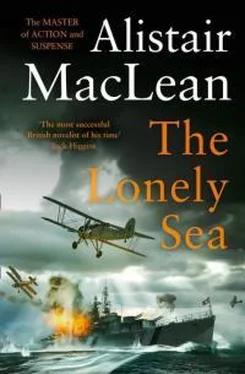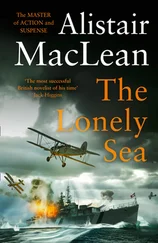And what part, people were asking bitterly, was Britain’s mighty Home Fleet playing in all this. Our first line of defence, our last hope in the darkest hour, why wasn’t it throwing all its great weight into these life and death battles? Why wasn’t it patrolling the North Sea and the English Channel (where the Stukas and the Heinkels could have destroyed it between dawn and sunset on any given day) ready to smash any cross-Channel invasion? Why hadn’t it helped in the evacuation of Greece? Why wasn’t it north of Crete, breaking up the seaborne reinforcements without whom Goering’s paratroopers could not hope to complete their conquests? Why wasn’t it at sea, bringing its great guns to bear for the protection of these threatened convoys in the submarine infested waters to the west? Why was it lying idle, powerless and useless, in its retreat in Scapa Flow? Why, why, why?
The Bismarck was the reason why: an overpowering reason why.
Laid down in 1936, launched from the Blohm and Voss shipyards in Hamburg on 14 February, 1939, in the presence of no less a person than the Chancellor of the Third Reich, Adolf Hitler himself, the Bismarck was something to haunt the dreams – or nightmares – of foreign navies the world over. Hitler had a genius for exaggeration, but there was no hint of exaggeration in what he said to its crew when he visited the battleship again in early May, 1941, only the simple truth. ‘The Bismarck, ’ he told them, ‘is the pride of the German Navy.’
She was indeed. She would have been the pride of any navy in the world. Built in cynical disregard of the 35,000 tons treaty limitations, with an actual tonnage somewhere in the region of 50,000, she was unquestionably the most powerful battleship afloat. She was fast, her speed of over 30 knots a match for any British capital ship: she had an immense beam – far greater than that of any British ship – which provided a magnificently stable firing platform for her eight 15-inch and twelve 6-inch guns – and the German gunnery, far superior to ours, was legendarily accurate under any conditions: and with her heavy armour-plating, double and triple hulls and the infinitely complex sub-compartmentation of the hull itself achieving a hitherto impossible degree of watertight integrity, she was widely believed to be virtually unsinkable. She was the trump card in Admiral Raeder’s hand – and now the time had come to play that trump.
The Bismarck was out. There could no longer be any question about it. First reported by reconnaissance as moving up the Kattegat on 20 May, she had been photographed in the company of a ‘Hipper’ class cruiser, by a Spitfire pilot, in Grimstad fjord, just south of Bergen, on the early afternoon of the 21st; at 6.00 p.m. the following day, a Maryland bomber from the Hatston naval air base in the Orkneys, skimming low over the water in appalling flying conditions, flew over Grimstad and Bergen and reported that the Bismarck was no longer there.
The Bismarck was out, and there could be no mistake where she was going. There were no Russian convoys to attack – Russia was not yet in the war. She could be racing only for the Atlantic, with the ‘Hipper’ cruiser – later identified as the Prinz Eugen – as her scout, there to savage and destroy our Atlantic convoys, our sole remaining lifelines to the outer world. The ‘Hipper’ itself, only a 10,000 ton cruiser, had once fallen upon a convoy and sent seven ships to the bottom in less than an hour. What the Bismarck could do just did not bear contemplation.
The Bismarck had to be stopped, and stopped before she had broken loose into the Atlantic, and it was for this single, precise purpose of stopping her that Admiral Sir John Tovey, Commander-in-Chief of the Home Fleet, had so long and so doggedly held his capital ships based on Scapa. Now was the time for the Home Fleet to justify its existence.
Admiral Tovey, a master tactician who was to handle his ships impeccably during the ensuing four days, was under no illusions as to the grave difficulties confronting him, the tragic consequences were he to guess wrongly. The Bismarck could break south-west into the Atlantic anywhere between Scotland and Greenland – a bleak, gale-ridden stretch of fully a thousand miles, with the all-essential visibility more frequently than not at the mercy of driving rain, blanketing snow and great rolling fog banks.
He had to station two squadrons, with two battleships in each squadron – he had no faith in the ability of any one ship of the line to cope with the Bismarck – at strategically vital positions some hundreds of miles apart, the Hood and the Prince of Wales south of Iceland, and his own flagship, the King George V, the Repulse and the carrier Victorious west of the Faroes, where, he hoped, they would be most favourably situated to move in any direction to intercept the Bismarck.
But they couldn’t move until they knew where the Bismarck was, and Admiral Tovey had had his watchdogs at sea for a long time now, waiting for this day to come. Between Iceland and the Faroes patrolled the cruisers Birmingham and Manchester, while up in the Denmark Strait the Suffolk and the Norfolk were coming to the end of a long long wait.
7.20 p.m., 23 May, 1941 and the Suffolk was steaming southwest down the narrow channel between the ice and the fog. If the Bismarck came by the Strait, Captain Ellis guessed, she would almost certainly come through that channel: the ice barred her way to the west, and, over on the east, no captain was going to take the risk of pushing his battleship through a dense fog at something like thirty knots, especially a fog that concealed a known minefield forty miles in length. If she were to come at all, that was the way she would come.
And that was the way she did come. At 7.22 p.m. the excited cry of a sharp-eyed lookout had Captain Ellis and all the watchers on the bridge peering intently through their binoculars out over the starboard quarter, the reported bearing, and one brief glance was enough for Ellis to know that their long exhausting wait was indeed over. Even for men who had never seen it, it was almost impossible to mistake the vast bulk of the Bismarck anywhere. (Or so one would have thought – it was to prove tragically otherwise less than twelve hours later.)
Captain Ellis was not disposed to linger. He had done the first – and most important – part of his job, the Bismarck and the Prinz Eugen, he suddenly realized, were only eight miles away, the Bismarck ’s guns were lethal up to a range of at least twenty miles, and there had been nothing in his instructions about committing suicide. Quite the reverse – he had been ordered to avoid damage to himself at all costs, to shadow the Bismarck and guide the battleships of the Home Fleet into her path. Even as the Suffolk ’s radio room started stuttering out its ‘Enemy located’ transmissions to Ellis’s immediate commander, Rear-Admiral Wake-Walker in the Norfolk and to Sir John Tovey in his battleship far to the south, he swung his cruiser heeling far over in a maximum turn to port and raced into the blanketing safety of the fog that swirled protectively around them only moments after they had entered it.
Deep in the mist, the Suffolk came round, manoeuvring dangerously in a gap in the minefields, the all-seeing eye of its radar probing every move of the German battleship as it steamed at high speed down through the Denmark Strait. Then, once it was safely past, both the Suffolk and the Norfolk moved into shadowing positions astern, and there they grimly hung on all through that long, vile Arctic night of snow-storms, rain-squalls and scudding mist, occasionally losing contact but always regaining it in what was to become a text-book classic in the extremely difficult task of shadowing an enemy craft at night. All night long, too, the radio transmissions continued, sending out the constantly changing details of the enemy’s position, course and speed.
Читать дальше












